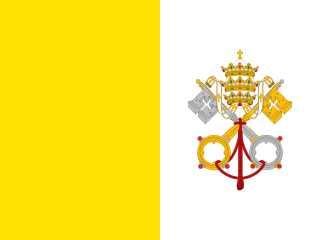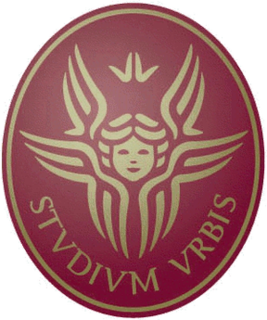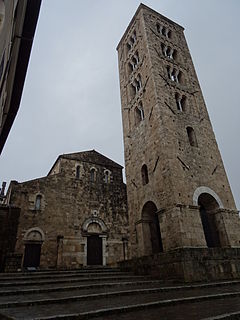
An antipope is a person who, in opposition to the one who is generally seen as the legitimately elected Pope, makes a significantly accepted competing claim to be the Pope, the Bishop of Rome and leader of the Roman Catholic Church. At times between the 3rd and mid-15th centuries, antipopes were supported by a fairly significant faction of religious cardinals and secular or anti-religious monarchs and kingdoms. Persons who claim to be pope, but have few followers, such as the modern sedevacantist antipopes, are not classified with the historical antipopes.

Constantinople was the capital city of the Roman Empire (330–395), of the Byzantine Empire, and also of the brief Crusader state known as the Latin Empire (1204–1261), until finally falling to the Ottoman Empire (1453–1923). It was reinaugurated in 324 from ancient Byzantium as the new capital of the Roman Empire by Emperor Constantine the Great, after whom it was named, and dedicated on 11 May 330. The city was located in what is now the European side and the core of modern Istanbul.

Vatican City, officially Vatican City State, is an independent city-state enclaved within Rome, Italy. Established with the Lateran Treaty (1929), it is distinct from yet under "full ownership, exclusive dominion, and sovereign authority and jurisdiction" of the Holy See. With an area of 44 hectares, and a population of about 1,000, it is the smallest state in the world by both area and population.

Pope Clement I, also known as Saint Clement of Rome, is listed by Irenaeus and Tertullian as Bishop of Rome, holding office from 88 to his death in 99. He is considered to be the first Apostolic Father of the Church, one of the three chief ones together with Polycarp and Ignatius of Antioch.

The Papal States, officially the State of the Church, were a series of territories in the Italian Peninsula under the direct sovereign rule of the Pope, from the 8th century until 1870. They were among the major states of Italy from roughly the 8th century until the Kingdom of Piedmont-Sardinia unified the Italian Peninsula by conquest in a campaign virtually concluded in 1861 and definitively in 1870. At their zenith, the Papal States covered most of the modern Italian regions of Lazio, Marche, Umbria and Romagna, and portions of Emilia. These holdings were considered to be a manifestation of the temporal power of the pope, as opposed to his ecclesiastical primacy.

Rome is the largest city in and the county seat of Floyd County, Georgia, United States. Located in the foothills of the Appalachian Mountains, it is the principal city of the Rome, Georgia, Metropolitan Statistical Area, which encompasses all of Floyd County. At the 2010 census, the city had a population of 36,303. It is the largest city in Northwest Georgia and the 19th largest city in the state.

The Capitolium or Capitoline Hill, between the Forum and the Campus Martius, is one of the Seven Hills of Rome.

The Catacombs of Rome are ancient catacombs, underground burial places under Rome, Italy, of which there are at least forty, some discovered only in recent decades. Though most famous for Christian burials, either in separate catacombs or mixed together, people of all the Roman religions are buried in them, beginning in the 2nd century AD, mainly as a response to overcrowding and shortage of land. The Etruscans, like many other European peoples, used to bury their dead in underground chambers. The original Roman custom was cremation, after which the burnt remains were kept in a pot, ash-chest or urn, often in a columbarium. From about the 2nd century AD, inhumation became more fashionable, in graves or sarcophagi, often elaborately carved, for those who could afford them. Christians also preferred burial to cremation because of their belief in bodily resurrection at the Second Coming. The Park of the Caffarella and Colli Albani are nearby.
The plebs were, in ancient Rome, the general body of free Roman citizens who were not patricians, as determined by the census. The precise origins of the group and the term are unclear, though it may be that they began as a limited political movement in opposition to the elite (patricians) which became more widely applied.

Rome—Ciampino International Airport "G. B. Pastine", is the secondary international airport of Rome, the capital of Italy, after Rome-Fiumicino Airport "Leonardo da Vinci". It is a joint civilian, commercial and military airport situated 6.5 NM south southeast of central Rome, just outside the Greater Ring Road the circular motorway around the city.

The Basilica Papale di San Lorenzo fuori le Mura is a Roman Catholic Papal minor basilica and parish church, located in Rome, Italy. The Basilica is one of the Seven Pilgrim Churches of Rome and one of the five former "patriarchal basilicas", each of which was assigned to the care of a Latin Church patriarchate. The Basilica was assigned to the Patriarchate of Jerusalem. The Basilica is the shrine of the tomb of its namesake, Saint Lawrence, one of the first seven deacons of Rome who was martyred in 258. Many other saints and Bl. Pope Pius IX are also buried at the Basilica, which is the center of a large and ancient burial complex.

The International Canoe Federation (ICF) is the umbrella organization of all national canoe organizations worldwide. It is headquartered in Lausanne, Switzerland, and administers all aspects of canoe sport worldwide. 157 countries are affiliated with the ICF after seven national federations were added at the 2008 ICF Congress in Rome.

The Sapienza University of Rome, also called simply Sapienza or the University of Rome, is a collegiate research university located in Rome, Italy. Formally known as Università degli Studi di Roma "La Sapienza", it is one of the largest European universities by enrollments and one of the oldest in history, founded in 1303. The University is one of the most prestigious Italian universities, commonly ranking first in national rankings and in Southern Europe.

Rome is a British-American-Italian historical drama television series created by John Milius, William J. MacDonald, and Bruno Heller. The show's two seasons were broadcast on HBO, BBC Two, and Rai 2 between 2005 and 2007. They were later released on DVD and Blu-ray. Rome is set in the 1st century BC, during Ancient Rome's transition from Republic to Empire.

The 'Rome' apple is a cooking apple originating near Rome Township, Ohio, in the early 19th century. It remains popular for its glossy red fruit and for its utility in cooking.
Vincenzo Seratrice the Elder was an Italian painter, mainly of genre paintings, archaeologist, antiquarian and furniture maker.

Rome: Rise and Fall of an Empire is a TV documentary series aired on the History channel in 2008. The 13-episode series starts at the transition period of the Roman Republic to the Roman Empire in the 2nd century BC, and ends with the story of the last Western Roman emperor in the 5th century AD.

Anagni Cathedral is a Roman Catholic cathedral in Anagni, Lazio, Italy, notable as the summer residence of the Popes for centuries. It is dedicated to the Annunciation of the Blessed Virgin Mary.

















